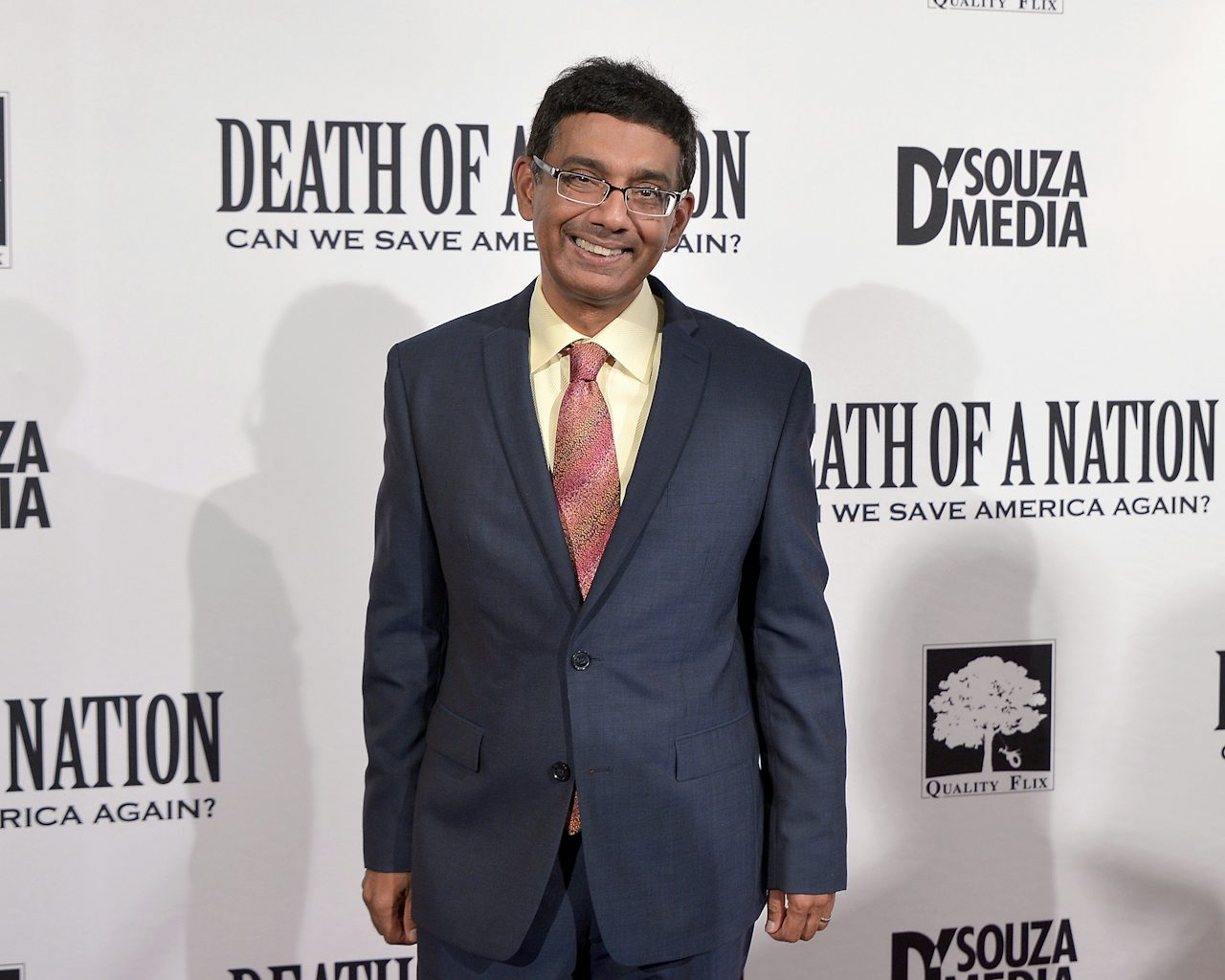Conservative propagandist Dinesh D’Souza has outdone himself with his new documentary Death of a Nation: Can We Save America a Second Time? Building upon his previous film, 2016’s Hillary’s America, D’Souza, who in 2014 was sentenced to five years’ probation for making illegal campaign contributions, further explores the possibilities of searching stock footage databases for “racist stuff” and blaming it on Hillary Clinton. For you, reader, I braved the line of six octogenarians waiting for the premiere at my local cineplex. I even forewent a soft drink to avoid having to walk out of the theater early, an act I feared my fellow audience members might misconstrue as me being “triggered.” I watched all 109 minutes, and I hated it.
The documentary’s theatrical poster shows President Donald Trump’s face melded with Abraham Lincoln’s, and the press materials give the impression that this comparison is the heart of the documentary: “Inspired by the turbulent events of post-2016 presidential election America, Dinesh D'Souza's Death of a Nation reveals an eerie similarity between the situations faced by President Trump now and the situations faced by President Lincoln in 1860.” In fact, D’Souza barely addresses this dubious theory in his narration. Trump is referenced, and not-particularly-relevant portions of Lincoln speeches are interspersed at random, but the argument is hardly the film’s thesis. What happened? Obviously, there aren’t a whole lot of genuine commonalities between Trump and Lincoln to dig into, but there are even fewer between modern Democrats and Adolf Hitler — and such is the comparison on which three-quarters of the movie rest.
D’Souza’s thesis has not evolved much since Hillary’s America: Liberals are the real racists, and not just regular racists, but full-blown goose-stepping brown-shirted Nazis. This superficially attractive but easily refutable idea has simmered for years as a third-string talking point, typically expressed in the form of facile gotchas (it was called the National Socialist party!) rather than fleshed-out arguments. This is because the thesis gets weaker, not stronger, when combined with additional evidence and historical context. The contradictions pile up until the argument is so flimsy that a question, any question, can send the whole thing crashing down.
To a regular conservative ideologue, the “liberals are the real racists” argument is helpful in a pinch, but not worth expending much effort on when there are easier lines of attack. D’Souza, on the other hand, is absolutely in love with it. He has now written three books (Stealing America, The Big Lie, and this film’s companion Death of a Nation) and two critically panned documentaries on the supposed continuity between slavery, Auschwitz, and the policies of Barack Obama and Hillary Clinton. The fact that each venture makes less sense than the last only seems to further energize him.
Despite the monumental effort D’Souza has put into injecting this talking point into the soft brains of his intended audience, most of what he presents rests on a shockingly small handful of decontextualized historical tidbits. Anyone unfortunate enough to have also seen 2016’s Hillary’s America will recognize almost all of these. Were you aware that that Democrat Woodrow Wilson screened the racist film Birth of a Nation in the White House? If not, D’Souza helpfully reenacts it a second time. Did you know that Planned Parenthood founder Margaret Sanger voiced support for eugenics, or that Hitler admired the 19th-century American policy of Manifest Destiny? What about the biggest bombshell of all, that Abraham Lincoln was a member of the Republican Party, the very same party to which Trump belongs? These factoids are strung together with no attention to chronology or narrative, making an already terminally confused argument even more difficult to follow.
The term Nazi is a compression of the terms " National" and "Socialist" (Sozialismus)--hence all Nazis are by definition on the Left pic.twitter.com/ks5guRXpgK
— Dinesh D'Souza (@DineshDSouza) October 5, 2017
When he is not reciting the five or six historical facts he knows, D’Souza lets his imagination run wild. B-roll and historical reenactments make up the vast majority of Death of a Nation’s runtime, and this is where D’Souza has developed (or deteriorated) most as a filmmaker since his last offering. Hillary’s America certainly had its share of superfluous historical reenactments — the worst of which showed slaves being whipped in graphic detail — but those were explicitly described as examples of Democratic evil.
In Death, D’Souza mostly neglects to make those connections, leaving the audience stranded in lengthy historical reveries with little relevance to modern American politics. The opening scene — the opening scene — is a bloody reenactment of Hitler’s 1945 suicide and makeshift cremation outside his bunker. The film’s title appears, and then it cuts to a reenactment of D’Souza reading as a child in India, with a narration along the lines of “when I was a boy, I liked to study history, which made me love America.” The whole thing is like this.
During a brief respite from Nazi reenactments, we see a montage of liberal TV pundits scoffing at the idea of Trump winning the 2016 election and then reacting with disbelief as the results came in on November 8. This segment is nearly identical to a number of popular YouTube compilations mistakenly recommended to me over the past two years and, indeed, many of D’Souza’s clips appear to have been downloaded from YouTube in a resolution that looks less than stellar on a 40-foot screen. From there, the order of Death of a Nation’s segments is seemingly random. There are archival clips of antifa throwing bricks, an Abraham Lincoln impersonator giving speeches to an empty wheat field, Benito Mussolini having an exaggerated eureka moment while reading Das Kapital, a pointless interview with Richard Spencer, and what must be a cumulative 30 minutes of D’Souza walking pensively around Berlin thinking about Hitler.
The Nazi 25 point platform reads like a Bernie Sanders wish list—Nazis campaigned as socialists & expanded state control as socialists do https://t.co/oYAd753A2s
— Dinesh D'Souza (@DineshDSouza) October 6, 2017
The strangest — and by far the longest — segment is a miniature biopic of Sophie Scholl, a prominent member of the White Rose resistance in Nazi Germany. We follow Scholl around Munich as she types and distributes banned leaflets throughout the city before the Nazis catch her, interrogate her, and eventually execute her by guillotine. The point of this lengthy subplot is unclear. It can be presumed that the Nazis are meant to represent socialism, liberalism, and the Democratic Party, which are all one and the same in the D’Souza cinematic universe. Scholl, then, is probably a stand-in for D’Souza, who believes that his 2014 felony conviction was an act of censorship straight from Obama’s desk.
But where Scholl wrote anti-Nazi pamphlets at great risk and was executed at the age of 21, D’Souza wrote two viciously racist books about Obama’s socialist African plot to destroy America, made a fortune, and later spent eight months in a halfway house for a blatant campaign finance violation. (He was pardoned by Trump earlier this year.) D’Souza comparing himself to political dissidents murdered by the Nazis would be the height of hubris in any case, but in a context this dull it just feels like a waste of good provocation. It takes a certain talent to put so many offensive things in a blender — concentration camp footage, black actors in rags picking cotton, Hitler blowing his brains out — and end up with something so painfully boring.


